#CelineWandersAndWondersInParis
Explore tagged Tumblr posts
Text







.
Wednesday Wanderings and Wonderings - Journées Européenne du Patrimoine* Edition.
Écoles des Mines de Paris at the Hôtel de Vendôme in Jardin du Luxembourg.
I visited this one as a nod to hubby since he wasn’t in Paris. Found out afterwards he had visited it on a previous Journée du Patrimoine. Oh well.
For those of you who don’t know us IRL, hubby and I met at Colorado School of Mines…. He was there studying, I was there partying (just to be clear 😂). Would we have met if he had gone to this “School of Mines”? What I can tell you is that the buildings in Paris are beautiful, and you can feel the history walking thru the corridors. I’m not saying that the one in Colorado doesn’t hold lots of history (I remember students who had their dads and granddads going to the school) but I don’t remember the beautiful buildings. I do remember it was across the street from The Coors Brewery. So there’s that in their corner 😂😂
And now the history blah blah:
Mines Paris – PSL, officially École nationale supérieure des mines de Paris (until May 2022 Mines ParisTech, also known as École des mines de Paris, ENSMP, Mines de Paris, les Mines, or Paris School of Mines), is a French grande école and a constituent college of PSL Research University. It was originally established in 1783 by King Louis XVI. The school disappeared at the beginning of the French Revolution but was re-established by decree of the Committee of Public Safety in 1794. It moved to Savoie, after a decree of the consuls in 1802. After the Bourbon Restoration in 1814, the school moved to the Hôtel de Vendôme (in the 6th arrondissement in Paris' Jardin du Luxembourg). From the 1960s onwards, it created research laboratories in Fontainebleau, Évry, and Sophia Antipolis (Nice).
* European Heritage Days (EHD) is a joint action of the Council of Europe and the European Commission involving all 50 signatory states of the European Cultural Convention under the motto, Europe: a common heritage. The annual programme offers opportunities to visit buildings, monuments and sites, many of which are not normally accessible to the public.
3 notes
·
View notes
Text

.
Wednesday Wanderings and Wonderings - Journées Européenne du Patrimoine* Edition.
La Tour Chicago.
If I’m being honest I wanted to go visit La Cour des Comptes (Court of Auditors) not only because it’s a very nice building but the main reason was to be able to see one of the first skyscrapers in the capital built fireproof and invisible from the street: Chicago Tower.
Its name comes from its architectural inspiration. With its ten floors on the surface (two in the basement), the Chicago Tower is one of the first skyscrapers of the capital. It was built in 1898 in non-combustible materials to house the archives of the Court of Auditors in the most secure way possible. In 2009, it was transformed into an office tower.
One very small skyscraper indeed.
NB: there’s a high limit of 37m/121ft (about 12 floors) for all construction in Paris intra muros (it was put in place in 1977 until 2010 and got reinstated again last year)


* European Heritage Days (EHD) is a joint action of the Council of Europe and the European Commission involving all 50 signatory states of the European Cultural Convention under the motto, Europe: a common heritage. The annual programme offers opportunities to visit buildings, monuments and sites, many of which are not normally accessible to the public.
4 notes
·
View notes
Text






.
Wednesday Wandering And Wondering - Bibliothèque Sainte Geneviève.
This is a hard place to get a tour of. Once I got in I realized why. They only take 5 people per day. But our guide was a delight and extremely knowledgeable. I really wanted to see the reading room Salle Labrouste. Bibliothèque Nationale de France is still my favorite but I have a few more on my list to visit.
Sainte-Geneviève Library (is a university library of the universities of Paris, administered by the Sorbonne-Nouvelle University located across the Panthéon.
It is based on the collection of the Abbey of St Genevieve, which was founded in the 6th century by Clovis I. The collection of the library was saved from destruction during the French Revolution. A new reading room for the library, with an innovative iron frame supporting the roof, was built between 1838 and 1851 by architect Henri Labrouste. The library contains around 2 million documents, and currently is the principal inter-university library for the different universities of Paris.
2 notes
·
View notes
Text









.
Wednesday Wanderings and Wonderings - Basilica Cathedral of Saint Denis.
A couple months ago, I took a little trip in the suburbs with a friend and it just happened that it was Fete de la ville de Saint Denis so entrance fee was waived.
La Basilique-cathédrale de Saint-Denis is a large former medieval abbey church and present cathedral in the commune of Saint-Denis, a northern suburb of Paris. The building is of singular importance historically and architecturally as its choir, completed in 1144, is widely considered the first structure to employ all of the elements of Gothic architecture.
The basilica became a place of pilgrimage and a necropolis containing the tombs of the kings of France, including nearly every king from the 10th century to Louis XVIII in the 19th century. Henry IV of France came to Saint-Denis formally to renounce his Protestant faith and become a Catholic. The queens of France were crowned at Saint-Denis, and the regalia, including the sword used for crowning the kings and the royal sceptre, were kept at Saint-Denis between coronations.
3 notes
·
View notes
Text










.
Wednesday Wanderings and Wonderings - Journées Européenne du Patrimoine* Edition.
Ministère de la Justice at Hotel Bourvallais on Place Vendôme.
The gorgeous office and meeting rooms used by all the Ministers of the justice department. Play we got to see the different Seals and the history of them.
The Ministry of Justice, founded in 1790, is a ministerial department of the Government of France, also known in French as la Chancellerie. It is headed by the Minister of Justice, also known as the Keeper of the Seals, a member of the Council of Ministers. The French Ministry of Justice prepares laws and regulations in a wide range of areas and guarantees the proper functioning of the judiciary (courts and tribunals). It also defines and implements public policies relating to justice: access to law and justice, combating domestic violence, etc.
Since the Fifth Republic, after sealing the Constitution of October 4, 1958, it became common practice to seal some constitutional modifications. It was last used in March during a public ceremony on International Women's Day for an amendment enshrining abortion rights into the French constitution. [Ed. note: Right women have since 1975 in France] France is the first nation to guarantee the right to an abortion in its national charter. According to Macron, this decision was spurred by the 2022 U.S. Supreme Court decision to rescind long-held abortion protections. Last year, Macron pledged to protect the right to abortions in France following the U.S. decision.
* European Heritage Days (EHD) is a joint action of the Council of Europe and the European Commission involving all 50 signatory states of the European Cultural Convention under the motto, Europe: a common heritage. The annual programme offers opportunities to visit buildings, monuments and sites, many of which are not normally accessible to the public.
2 notes
·
View notes
Text









.
Wednesday Wanderings and Wonderings - Journées Européenne du Patrimoine* Edition.
Got to visit the beautiful building of La Cour des Comptes (Cour of Audit) and learn about the ins and outs of the institution.
The Cour des Comptes ("Court of Accounts") is France's supreme audit institution, under French law an administrative court. As such, it is independent from the legislative and executive branches of the French Government. However, the 1946 and 1958 French constitutions made it the Court's duty to assist the Cabinet and Parliament in regulating government spending. The Court thus combines functions of a court of exchequer, comptroller general's office, and auditor general's office in common-law countries. It is also a Grand Corps of the French State and mainly recruits among the best-ranked students graduating from the Ecole nationale d'administration.
*European Heritage Days (EHD) is a joint action of the Council of Europe and the European Commission involving all 50 signatory states of the European Cultural Convention under the motto, Europe: a common heritage. The annual programme offers opportunities to visit buildings, monuments and sites, many of which are not normally accessible to the public. It aims to widen access and foster care for architectural and environmental heritage. The event began in France in 1984, with La Journée portes ouvertes dans les monuments historiques, sponsored by the Ministry of Culture. In 1985, in Granada, at the 2nd European Conference of Ministers responsible for Architectural Heritage, the French Minister of Culture proposed that the project be internationalised under the Council of Europe. The Netherlands held their first Open Monumentendag in 1987. Sweden and the Republic of Ireland joined in 1989, as well as Belgium and Scotland in 1990. In 1991 these events were united as European Heritage Days at the initiative of the Council of Europe, supported by the EU. By 2010, 50 signatory states of the European Cultural Convention had joined the EHDs.
4 notes
·
View notes
Text





.
Wednesday Wanderings and Wonderings - Sainte Chapelle
We are back with Wednesday Wanderings and Wonderings!
Sainte Chapelle is (nowadays I should say was) often on my daily walk and each time I walked by and saw the line I told myself I really needed to go see it but I always delayed because I wanted to go on a sunny day. Cut to friends visiting Paris and one of the places they had never been was Sainte Chapelle. Because of the Olympics the queue was shorter and we got in really fast.
Oh my what a beauty. Pictures don’t do it justice and I can’t even imagine on a bright sunny day (it was a bit cloudy when we went). We didn’t have time to do the conciergerie visit (often done together as it’s close by) but it next on my list.
The Wikipedia part: The Sainte-Chapelle is a royal chapel in the Gothic style, within the medieval Palais de la Cité, the residence of the Kings of France until the 14th century, on the Île de la Cité in the River Seine in Paris, France. Construction began sometime after 1238 and the chapel was consecrated on 26 April 1248. The Sainte-Chapelle is considered among the highest achievements of the Rayonnant period of Gothic architecture. It was commissioned by King Louis IX of France to house his collection of Passion relics, including Christ's Crown of Thorns – one of the most important relics in medieval Christendom. This was later held in the nearby Notre-Dame Cathedral until the 2019 fire, which it survived. (The extended explanation is here)
2 notes
·
View notes
Text


.
Wednesday Wanderings and Wonderings - Bourse du Commerce.
Since 2021, the building has been the Parisian exhibition site of the Pinault Collection (on a 50-year lease). The dome of the building is listed as a historical monument.


The Bourse de commerce (Commodities Exchange) was originally used as a place to negotiate the trade of grain and other commodities, and used to provide services to businesses by the Paris Chamber of Commerce during the latter part of the 20th century. It has its origins in a circular wheat exchange built in 1763–67, with an open-air interior court that was later capped by a wooden dome replaced in 1811 with a copper one (supported by an iron skeletal structure). In a major reconstruction in 1888–89 much of the structure was replaced, although the layout remained the same and the dome was retained albeit adding glass and a mounted canvas. With the computerization of futures markets, in 1998 market activity ended at the Bourse de Commerce building. (Wikipedia)
I never really paid attention to the back of the building (I rarely arrive from that side) but attached to the south-east of the building there’s a column: The Medici Column.


A mysterious column perfectly integrated with the Paris Commodities Exchange, yet it precedes two centuries! At the site of the current Commodities Exchange was in effect until the 18th century a vast mansion, the Hotel de Soissons. The column that you can still see today was built in 1574. A column of 31 meters high and 3 meters wide with a staircase of 147 steps, which provided access to the top platform
6 notes
·
View notes
Text


.
Wednesday Wanderings and Wonderings - La Fontaine des Mers (Place de la Concorde)
It is one of two monumental fountains designed by Jacques Ignace Hittorff and inaugurated in 1840, with the other being the Fontaine des Fleuves.
The Fountain of the Seas is devoted to the Atlantic and Mediterranean with accompanying figures - astronomy, commerce harvesting of coral, pearls and fish and navigation. (The Fountain of the Rivers, on the other side of the plaza, is dedicated to the Rhone and Rhine and displays figures of industry, harvesting flowers and crops and river navigation)
PS. I will photograph the other fountain (Fontaine des Fleuves) in the summer when the water is running. Both fountains have been under refurbishment so couldn’t take pictures until now.
3 notes
·
View notes
Text

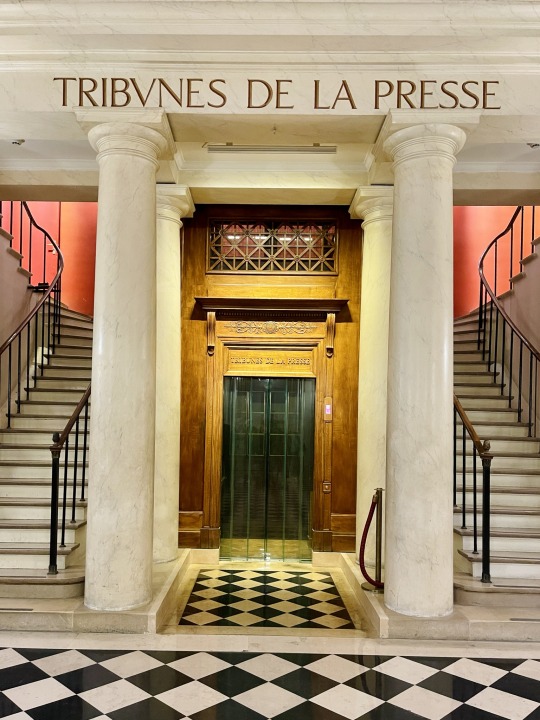
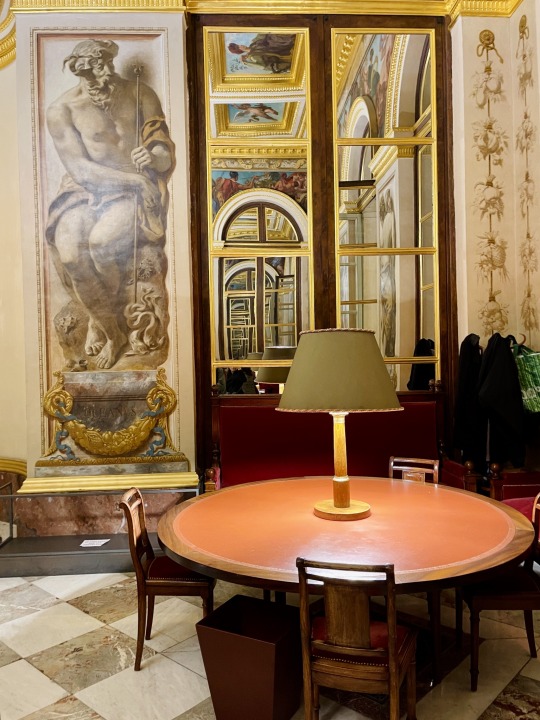

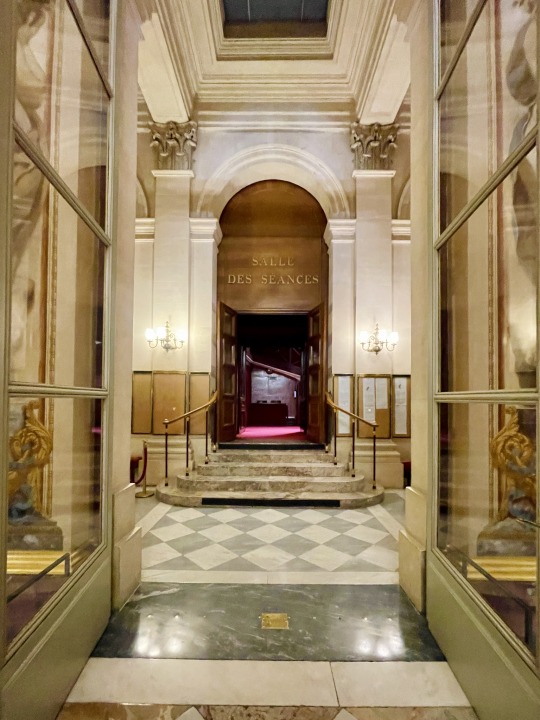



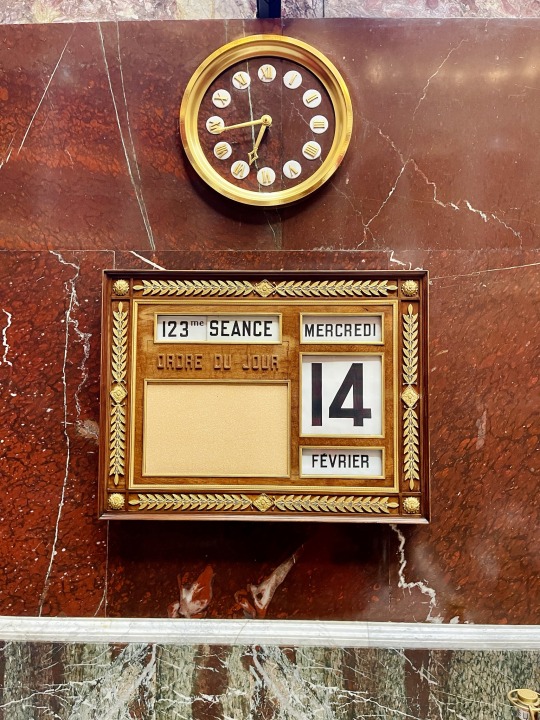

.
Wednesday Wanderings and Wonderings - Palais Bourbon & l’Assemblée Nationale
While I walk by the palais Bourbon quite regularly, it’s in the other side of the Seine from Place Concorde, I finally decided to book a tour (it’s free). You can also assist to a seance since they are open to the public (you just need to register)
PS: The Bibliothèque (library) was under refurbishment so I’ll have to go back… from the pictures I saw it is stunning.
And if you want to read more about l’Assemblée Nationale… here you go:
The National Assembly is the lower house of the French Parliament, the upper house being the Senate (Sénat). The National Assembly's legislators are known as députés meaning "delegate" or "envoy" in English.
There are 577 députés, each elected by a single-member constituency (at least one per department) through a two-round system; thus, 289 seats are required for a majority. The president of the National Assembly, currently Yaël Braun-Pivet (Side note: she’s the first woman as president and out of her 6 vice-presidents 5 are women yeah!!), presides over the body. The officeholder is usually a member of the largest party represented, assisted by vice presidents from across the represented political spectrum. The National Assembly's term is five years; however, the President of France may dissolve the Assembly, thereby calling for early elections, unless it has been dissolved in the preceding twelve months. This measure has become rarer since the 2000 French constitutional referendum reduced the presidential term from seven to five years. Due to the separation of powers, the President of the Republic may not take part in parliamentary debates.
Following a tradition started by the first National Assembly during the French Revolution, the left-wing parties sit to the left as seen from the president's seat and the right-wing parties to the right; the seating arrangement thus directly indicates the left–right political spectrum as represented in the Assembly. Like most institutions of importance in Paris, it is guarded by Republican Guards.
Since 1988, the 577 deputies are elected by direct universal suffrage for a five-year mandate. The constituencies each have about 100,000 inhabitants. The deputy for the most populous (within Val-d'Oise), represented 188,000 voters, while that for the other extreme (for Lozère at-large), represented 34,000. That for Saint Pierre and Miquelon serves fewer than 6,000. Most were redrawn in 2009 and the creation of eleven constituencies for French residents overseas
Of the 577 elected deputies, 539 represent metropolitan France, 27 represent the overseas departments and overseas collectivities; 11 represent French residents overseas. => Jeremy and I voted in Singapore a couple months before we left.
2 notes
·
View notes
Text

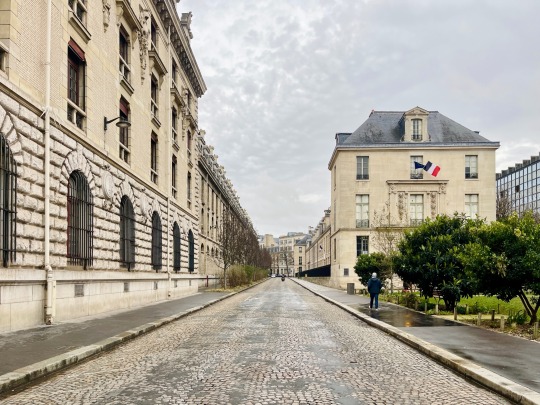
.
Wednesday Wanderings and Wonderings - La Garde Républicaine headquarters at Quartier des Célestins
The Garde républicaine (Republican Guard) is part of the French National Gendarmerie. It is responsible for special security duties in the Paris area and for providing guards of honour at official ceremonies of the French Republic.
It consists of two infantry regiments (one includes a motorcycle squadron) and a horse cavalry regiment. It also has four musical formations, as well as display teams demonstrating prowess in horseback or motorcycle maneuvers. The Guard is commanded by a general de division (major general). It is headquartered in the Quartier des Célestins, Paris, built in 1895–1901, designed by the renowned French architect Jacques Hermant.
Its missions include guarding important public buildings in Paris, such as the Élysée Palace (the residence of the President of the French Republic), the Hôtel Matignon (the residence of the Prime Minister of France), the Luxembourg Palace (the Senate), the Palais Bourbon (the National Assembly) and the Palais de Justice, as well as keeping public order in Paris. Ceremonial and security services for the highest national personalities and important foreign guests, military ceremonies and guards of honour for fallen soldiers, support of other law enforcement forces with intervention teams, as well as staffing horseback patrol stations are also part of its duties.
2 notes
·
View notes
Text
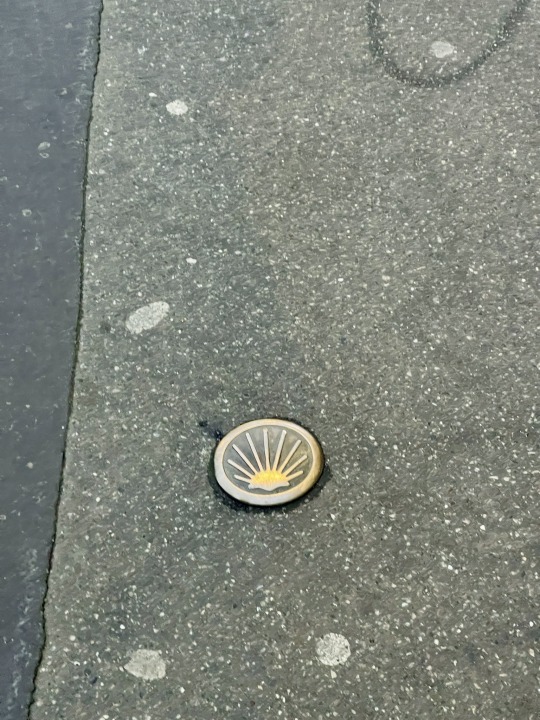
.
Wednesday Wanderings and Wonderings - Sur le chemin de Saint Jean de Compostelle.
While walking around Paris and especially around my neighborhood, because I live next to Tour Saint Jacques, I had noticed on the streets those “clou” with a cockle-shell-like design that marks the Chemin de Saint Jean de Compostelle/Camino de Santiago/Saint James Way.
The Camino de Santiago, or in English the Way of St. James, is a network of pilgrims' ways or pilgrimages leading to the shrine of the apostle James in the cathedral of Santiago de Compostela in Galicia in northwestern Spain, where tradition holds that the remains of the apostle are buried. Pilgrims arriving at Compostela were given a cockle-shell as proof of their achievement, and these were great status symbols.
While the Via Podiensis, starting in le Puy, it is the traditional route for pilgrims from Switzerland and eastern France, and by far the most popular for modern pilgrims (20 to 25 000 pilgrims take this route every years and cover the 1,515 km to reach the cathedral of Santiago de Compostela in Galicia). This is the one which is normally referred to in English as the Way of Saint James, although all four are strictly speaking Ways of Saint James.
The one in Paris is part of Via Turonensis (Way of Tours) used by pilgrims from the Netherlands and the Paris basin. English pilgrims often joined this route via Angers.
There is also Via Tolosana (Way of Arles) The main route for pilgrims coming from the south of France and Italy. The Latin name refers to Toulouse, the biggest town on the route and Via Lemovicensis (Way of Vézelay), used by pilgrims coming from north-eastern France, Germany and Belgium. The Latin name refers to Limoges, one of the most important pilgrim sites along the way.
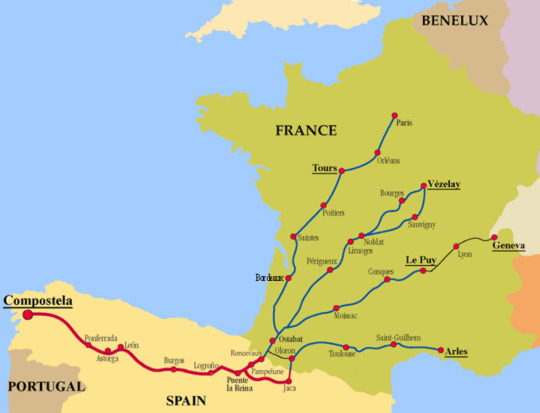
4 notes
·
View notes
Text




.
Wednesday Wanderings and Wonderings - The Passage Edition
Passage Verdeau (6, rue de la Grange Batelière – 31, bis rue du Faubourg Montmartre, 75009 Paris)
Opened in 1846 by the Société du Passage Jouffroy, it was named after one of the members of this society, Mr. Verdeau, who "invented" the renting of linen for hotels, restaurants or other receptions. In the continuation of the Jouffroy and Panoramas passages, it is one of the clearest and most airy passages, with its high fishbone glass roof and a very pure design of neo-classical lines.
Since the opening of the Hôtel Drouot, the Passage has attracted many collectors. In addition to old books, one finds in this passage, second-hand cameras, old furniture, embroideries. There are also several restaurants and tea rooms. (Source)
*** But what is a passage? It is a private road open to the public, a shortcut between several roads, whether covered or not. As a pedestrian space, the passage can house both commerce and housing. Only the abundant decoration and the luxury of the stores differentiate a gallery from a passage. It’s the ancestor of today's shopping malls, the unique charm of Parisian covered passages will immediately transport you to the 19th century (Previous Posts)***
#CelineIsNotAnExpatAnymore#France life#Paris#passages#CelineAndPassagesInParis#CelineWandersAndWondersInParis
7 notes
·
View notes
Text

.
Wednesday Wanderings and Wonderings - Fontaine Stravinsky
After 18 months of repair the colorful fountain is back.
It is also called the Fountain of Automatons. It is located near Centre Pompidou. These sculptures were commissioned by the Mayor of Paris Jacques Chirac. It was created by Jean Tinguely and Niki de Saint Phalle in 1983. This fountain is a tribute to the Russian composer Igor Stravinsky. There are 16 amusing or poetic sculptures that come to life on the water basin. Jean Tinguely chose black and steel and Nicky de Saint Phalle worked with fiberglass, polyester and color. Motors and water are used to set the sculptures in motion.
2 notes
·
View notes
Text

.
Wednesday Wanderings and Wonderings - Cirque d'hiver Bouglione.
When you think about a circus and its tent you envision something more temporary and leaving after their performance. In Paris there is one that is permanent and was built last century.
The Cirque d'Hiver ("Winter Circus") in the 11th arrondissement has been a prominent venue for circuses, exhibitions of dressage, musical concerts, and other events, including exhibitions of Turkish wrestling and even fashion shows. The theatre was designed by the architect Jacques Ignace Hittorff and was opened by Emperor Napoleon III on 11 December 1852 as the Cirque Napoléon. The orchestral concerts of Jules Etienne Pasdeloup were inaugurated at the Cirque Napoléon on 27 October 1861 and continued for more than twenty years. The theatre was renamed Cirque d'Hiver in 1870.
2 notes
·
View notes
Text
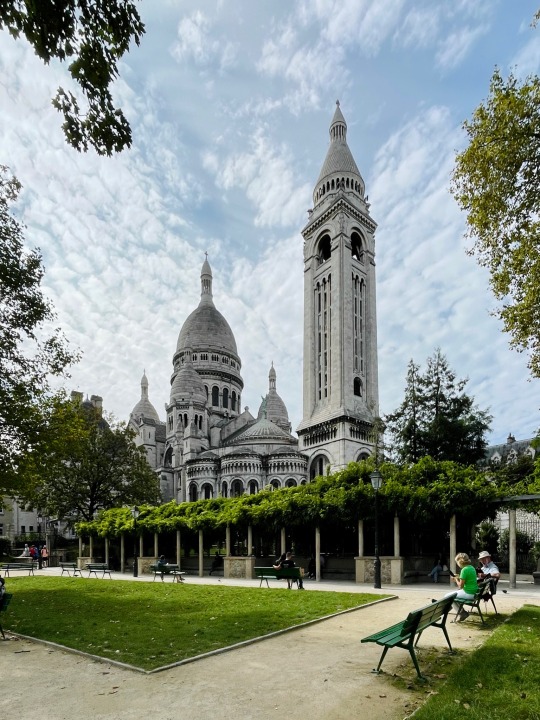
.
Wednesday Wanderings and Wonderings
Sometime the back is as beautiful as the front but a LOT less crowded.
I had arrived multiple time from the back way to Le Sacre Cœur in Montmartre but I had never noticed this secluded garden until I ventured in one day and realized that the photo of the Sacré Cœur from this perspective was great too, not as iconic as the front view but beautiful nevertheless.

Reminded me of the crowd looking at La Joconde in Le Louvre and totally ignoring Veronese's monumental Wedding Feast at Cana on the opposite wall.
3 notes
·
View notes